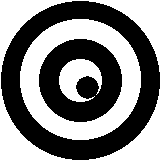 = man;
= man;  = woman.
= woman.
- r. = a step taken with the right foot; l. = a step taken with the left foot.
- The Set or the General Set is the area occupied or enclosed by the dancers in any given dance-formation.
- A Longways dance is one in which the performers take partners and stand in two parallel lines, the men on one side opposite and facing their partners on the other, those on the men's side ffacing the right wall, those on the woman's side the left wall.
- The disposition of the dancers in a longways dance is said to be proper when the men and women are on their own side; and improper when the men are on the woman's side or the women on the men's.
- A Progressive dance consists of the repetition for an indefinite number of times of a series of movements, called the Complete Figure, each repetition being performed by the dancers in changed positions. The performance of each Complete Figure is called a Round.
- A Progressive movement or figure is one the performance of which leaves the dancers relatively in different positions.
- A neutral dancer is one who, in a progressive dance, is passive during the performance of a Round.
- In dances or figures in which two couples only are engaged, the terms contrary woman and contrary man are used to denote the woman or man other than the partner.
- When two dancers standing side by side are directed to take hands they are to join inside hands; that is, the right hand of one with the left hand of the other, if the two face the same way; and right hands or left hands, if they face in opposite directions. When they are directed to take, or give, right or left hands, they are to join right with right, or left with left.
- To cross hands the man takes the right and left hands of the woman with his right and left hands respectively, the right hands being held above the left.
- When two dancers face one another and are directed to take both hands, they are to join right with left and left with right.
- To pass by the right is to pass right shoulder to right shoulder; by the left, left shoulder to left shoulder.
- When two dancers pass each other they should always, unless otherwise directed, pass each other by the right.
- To cast off is to turn outward and move up or down outside the General Set.
- To cast up or cast down is to turn outward and move up or down outside the General Ste.
- To fall is to dance backwards; to lead, or move, is to dance forwards.
- To make a half-turn is to turn through half a circle and face in the opposite direction; to make a whole-turn is to make a complete revolution.
- The terms clockwise and counter-clockwsie are self-explanatory and refer to the direction of circular movements [as viewed from above].
Page transcribed by Hugh Stewart
